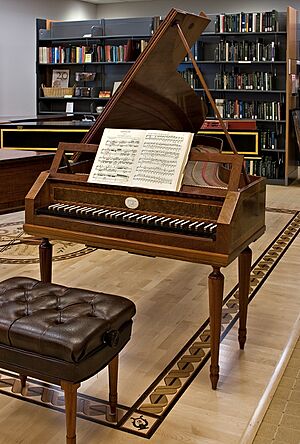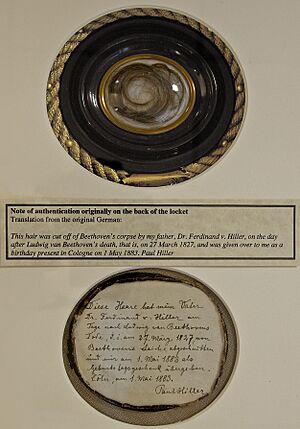Ira F. Brilliant Center for Beethoven Studies facts for kids

Visitors can play the reproduction of a 1795 Dulcken fortepiano.
|
|
| Formation | 1983, 42 years ago |
|---|---|
| Founder | Ira F. Brilliant |
| Location | |
| Owner | San Jose State University |
The Ira F. Brilliant Center for Beethoven Studies is a special place for anyone interested in the famous composer Ludwig van Beethoven. It works like a museum, a research library, and a place for concerts and talks. Everything here is about Beethoven's life and his amazing music.
This center is the only one of its kind in North America. It has the biggest collection of Beethoven's works and items outside of Europe. The center is run by San Jose State University and a group called the American Beethoven Society. You can find it on the fifth floor of the Dr. Martin Luther King Jr. Library in downtown San Jose, California.
Contents
History of the Center
The center started in 1983. A man named Ira F. Brilliant, who was a real estate developer from Arizona, gave his large collection of Beethoven items to San Jose State University. He wanted the university to use these items to create a special center about Beethoven.
Mr. Brilliant's collection was considered the best private collection of Beethoven items in the United States. It included 75 first editions of Beethoven's music. The center officially opened its doors to the public in 1985.
How the Center Works
The center is a team effort between San Jose State University and the American Beethoven Society. San Jose State University manages the center as a special part of its library. They provide the space and the staff who work there.
The American Beethoven Society helps by funding many of the center's activities. For example, they help pay for the Beethoven Journal, which is published twice a year. They also help buy new and important items for the collection.
What You Can Find in the Collection
The center's collection has grown a lot over the years. They have received many donations and bought new items. A big addition was in 1987 when they bought the collection of William S. Newman. He was a famous music expert and professor.
Books and Information
The center has over 4,000 books and publications about Beethoven. This includes a very rare magazine from 1783. This magazine was the first time Beethoven was ever mentioned in print! They also have copies of more than 8,000 articles about him.
There is also a large collection of microfiche. This is a way to store many documents in a very small space. It includes copies of all Beethoven's original music papers held by the Berlin State Library.
Music and Special Items
The center now has 300 first editions of Beethoven's music. This is the largest collection in North America. It includes first editions of all his and most of his.
They also have over 2,200 "early editions." These are copies of his music published during his lifetime or in the 1800s. There is a special area where you can listen to audio recordings and watch videos of performances. The center also has items written by Beethoven himself and a copy of his death mask.
The Guevara Lock of Hair
One of the most famous items at the center is a lock of Beethoven's hair. It is known as the Guevara Lock. This lock of hair was cut on March 27, 1827. This was just one day after Beethoven passed away.
A German composer and conductor named Ferdinand Hiller cut the hair. He had traveled to Vienna to be with Beethoven before he died. Hiller later gave the lock of hair to his son, Paul. Paul wrote about its history on the back of a locket that held the hair.
Later, the hair's journey is not fully known for a while. It reappeared in 1943. A Danish doctor named Kay Alexander Fremming received it as payment. He had given medical help to people escaping difficult times during World War II.
In 1994, the Fremming family sold the lock of hair at an auction in London. Four members of the American Beethoven Society bought it. These were Dr. Alfredo Guevara, Ira Brilliant, Dr. Thomas Wendel, and Caroline Crummey. The lock was named after Dr. Guevara because he was the main person who invested in buying it. He kept a small part of the hair and gave the rest to the Center for Beethoven Studies. The other investors also gave their parts to the center.
The original lock had 582 hairs. They were brown, white, and gray, and about three to six inches long. The Center for Beethoven Studies now has 422 of these hairs. They also have the original locket that Hiller used.
In 1996, Brilliant and Guevara had some of the hairs tested. The tests showed very high levels of lead in Beethoven's hair. This was 100 times more than normal! This discovery made many people think that lead poisoning might have caused Beethoven's poor health and perhaps even his death.
The story of this lock of hair and what it taught us about Beethoven's health is told in a book called Beethoven’s Hair. There was also a documentary film with the same name made for Canadian television.
Musical Instruments
The center has several musical instruments on display. These include an original 1827 Viennese fortepiano. A fortepiano is an early type of piano. There is also a copy of a 1795 Dulcken fortepiano. Other instruments include a clavichord and a harpsichord.
The Dulcken fortepiano is a copy of an original instrument kept at the Smithsonian Institution. It has 66 keys and can play five octaves. Visitors are allowed to play the Dulcken fortepiano, the clavichord, and the harpsichord.
See also
- List of music museums


